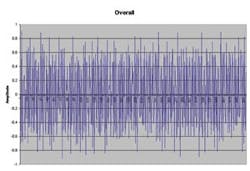You’ve spent the time tracking and balancing the helicopter as smoothly as possible. You’ve balanced the tail rotor and all available driveshafts. You’ve replaced a few components. You’ve even tightened the loose nut behind the stick. However, a vibration still remains in the aircraft. You’re left scratching your head with no further course of action. How do you continue your troubleshooting and find a resolution?
Most modern track and balance equipment contains a very powerful tool that you can use to improve the quality of information at your disposal. The vibration spectrum survey can bring quite a bit of seemingly unrelated data into an organized format that you can use as a valuable troubleshooting tool.
There are several things to keep in mind concerning the limits of the equipment itself. The first limit is that vibration sensors see all vibrations at the same time; the engineers call this the time domain (Figure 1). What this means is that using the raw data, you cannot identify a specific component with a problem. The sensor simply sees all the vibrations occurring at its location. The closer the sensor is to the source of the vibration, the more powerful the signal will be.
For this reason, it is often necessary to locate several sensors throughout the aircraft. Each sensor will see the entire range of vibration readings, but the sensors closest to the actual problem will show the greatest vibration amplitude levels. Once the raw data is gathered, some mathematical magic called Fast Fourier Transform will be performed inside the analyzer to convert the raw time data into data displayed in the frequency domain (Figure 2). What this means to us as mechanics is that now we can identify a specific frequency at which the vibration is occurring.
The vibration survey, converted to frequency units, will be displayed on the analyzer. Some analyzers will simply list numeric values for the peak vibration levels and the associated frequency. Some analyzers will actually display a graphical representation of the entire range of defined frequencies. These surveys are typically taken with the aircraft set at a single operating condition. For this reason, these vibration surveys are called steady state surveys.
Displaying the Data
Several different methods of displaying the steady state vibration survey plot exist. The first method is an exponential type of display. This plot displays the spectral plot as the data is processed. This display is constantly changing to reflect the operation of the component. The limit to this plot is that it is very difficult to capture a random vibration event. The only information saved is the information displayed at the time the data capture occurs.
The second method is the peak hold survey. It will display the highest peak at each individual frequency until it is replaced by a higher peak. It shows the “worst case” vibration at each specific frequency. This does not mean that the maximum vibration amplitude is occurring at each frequency during the entire duration of the run, it is simply a method to display the highest peaks recorded during a period of time.
Another type of plot is the waterfall plot (Figure 3). This type of plot captures a sample of the vibration survey and places them back to back for display on a single screen. It is possible to watch for trends or peaks that appear or disappear. The waterfall plot is very useful for recording operating conditions that change.
There is even equipment that can record the vibration survey in “real time” allowing the technician the ability to find a vibration in a specific operation condition. This type of survey is called the transient vibration survey. The transient vibration survey can gather data as the aircraft changes flight conditions.
Say the pilot complains of a vibration when the aircraft is accelerating to cruise speed. The vibration analysis equipment could be installed and securely mounted allowing data capture during a maintenance flight simulating the same conditions. A transient survey can be performed and saved inside the analyzer. The data can typically be downloaded to a computer for in-depth analysis. Once the data are saved in the computer, the higher-than-normal peaks can be identified and investigated. Now, how do you make sense of what you’re seeing on the screen?
Comparing Vibration Data to the Manual
Vibration data alone may not be much use. However, the data used in conjunction with the maintenance manual can identify the rotational speeds of all the major components on the aircraft. There is typically a list, a table, or a set of ratios useful in identifying specific components. Keep in mind, most tables are written with the component at 100 percent operating speed. In some cases it will be 100 percent of the actual component rotational speed. In other cases it may be in relation to engine speed, either N1 or N2 speed. When readings are taken at partial power, the rotational speeds will need to be adjusted mathematically to the correct partial operating speed.
For example, look at the starter/generator on an Allison 250-C20. The maintenance manual lists the rotational speed of the starter/generator gear as 12,034 rpm. Further up the gear train, the Gas Producer Turbine Input (N1), that ultimately drives the starter/generator, is listed at 50,970 rpm at 100 percent. This means that both gears are turning the rated rpm at 100 percent N1 speed. Rarely will the N1 power train be turning at 100 percent. Assume the data was gathered with the N1 operating at 87 percent. Multiplying the 100 percent rotational rpm by 87 percent will give us the approximate speed of the starter/generator. This speed is 10,469.58 rpm. Armed with this information, we can examine the vibration spectrum survey for a peak in the 10,500-rpm range. This process can be repeated to confirm that the rotational components are not producing vibration peaks above the manufacturer’s limits. Conversely, it is possible to identify a particular vibration spike and try to identify the component that caused it (Figure 4).
Identifying the Harmonics
Another consideration when trying to isolate vibration or noise problems is looking at a broad enough picture. The problem you are chasing can be in one of the multiples of the primary frequency, known as a harmonic. It is important to remember that every component has a primary frequency and one or more harmonic frequencies. For this reason, the suspicious frequencies need to be identified. Once the primary frequencies are identified, the harmonics can be identified. Then the overall range, or bandwidth, of the survey can be determined.
Corrective Action
Once a determination can be made concerning the component causing the problem, a path of corrective action can be established. Corrections can include balancing the offending component as in the case of a tail rotor or driveshaft. You can replace the suspect component as in the case of a starter/generator or fuel pump. The long-term solution would be to begin a trending program to identify the failure level of the component and remove it before a preset threshold.
This is the theory behind onboard monitoring systems. The data is gathered continuously during the flight. The option exists for an immediate notification presented to the pilot in the form of a caution light or gauge. Another option, if the information is not to be immediately displayed, is to store the data and decipher it later at a maintenance facility. The data will be tracked and the next course of action can be determined.
The ultimate goal is to use the tools at hand to provide effective troubleshooting information. Many times the warning signs for impending problems are noticed early in the failure cycle. If these warning signs can be identified and documented, the potential for catastrophic failure can be reduced. This can result in greater aircraft availability and reduced maintenance costs.

